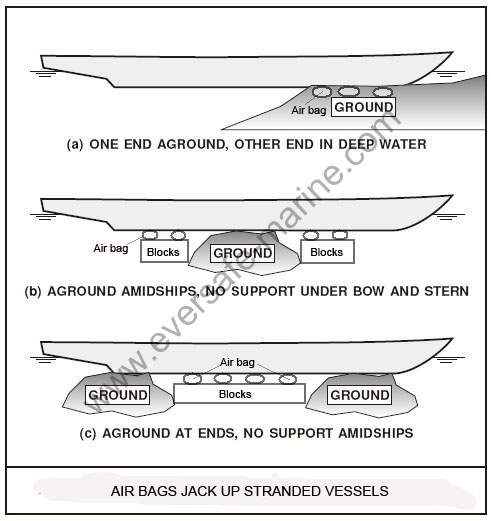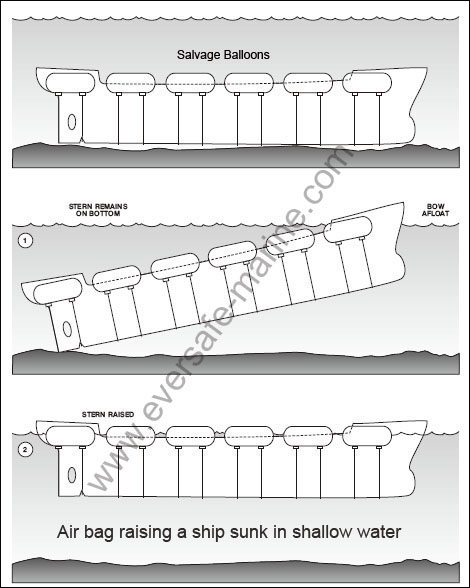Marine salvage tubes or salvage balloons are used extensively to jack up aground ship or refloat small ships and to stabilize the refloating process when larger ships are being raised—particularly in combined lifting operations.
Marine salvage tubes are different from rigid pontoons or inflatable pontoons and lift bags due to their heavy duty and versatile usages.
SALVAGE PONTOONS
The pontoons are steel cylinders, sheathed with wooden fendering. The pontoon is divided into three watertight compartments to permit better control of the pontoon through control of reserve buoyancy and ballast. Free surface and surging of the water from one end to the other are reduced. Each compartment of the pontoon has vent, flood, and relief valves.
The steel salvage pontoon can be employed in both deep and shallow water, as well as in the presence or absence of tide.
Salvage pontoons are not always the easiest salvage tool to use. They are heavy; an 80-ton lift capacity pontoon may weigh as much as 40 tons that are difficult to handle on the surface.
However, the advantage of the steel salvage pontoon in most salvage operations is that it can absorb a great deal of mistreatment, contact, and minor damage that would seriously damage or destroy inflatable lift bags.
LIFT BAGS
The parachute-type lift bag is available in a variety of sizes for salvage. Obtainable sizes give lifts from 5 to 35 tons. Parachute bags are rubberized fabric bags that have lifting straps bonded to them.
The enclosed-type lift bag is similar to the parachute-type except that the bag is totally enclosed and fitted with a relief valve. Bags with buoyant lifts from 5 to 35 tons are available.
Lift bags are not as rugged, nor as salvor-proof, as other compressed air lifting devices. Inflatable pontoons and lift bags must be handled carefully to avoid snags, tears, and punctures. And enclosed-type lift bags distort easily under tow which is desperate in some conditions.
SALVAGE TUBES (BALLOONS)
The salvage tubes are similar to enclosed-type lift bags while they are much stronger. They have evolved from ship launching airbags and have multi-plies reinforcement layers made of rubber and synthetic-tire-cords. The thickness of tube body exceeds 6 mm often.
Salvage balloons are extensively used for jack up stranded vessel and lifting sunk ship.
Salvage tube jack up operational notes
Jacking up function is the peerless character of our salvage tubes. When the mechanical lifts are not available or limited, salvage airbags are the most powerful tool to salvage stranded vessels. Below illustrations show what air bags can be used for jacking up ships.

To install air bags underneath vessel, people will only need 0.25 m×2.5 m×L m space. Where L is the length of air bags.
People may dig the channel to install deflated air bags or set up the support blocks with steel plate on top to create jack up base for marine air bags. One piece airbag with 1.5 m diameter and 15 m length can lift 250-450 tonnes load at 0.5 m height underwater.
When stranded ship is lifted by marine air bags, its bottom should be checked or repaired to ensure re-launch safety. Air bags roll out need a relatively flat ramp which can be completed by dredging or stacking sand sacks on gravel.
CAUTION: Salvage air bags should be keep safe from sharp solid objects such as steel bar, rock edges.
Salvage tube is a kind of lift equipment whose performance between rigid pontoon and common lift bag. It is lighter than pontoon but stronger than PVC lift bag, its buoyancy is smaller than pontoon but bigger than lift bag.
Salvage tube Air lift operational notes
Salvage tubes can be rigged together to offer bigger buoyancy but the imbalance force should be prevented. Experienced salvors will inflate air bags two end at same time or inflate two air bags in one bundle at two reverse ends.
Salvage tubes can be rigged into totally enclosed flooded spaces such as holds to dewater and restore buoyancy.Also salvage tubes can be secured to the sunken ship by ropes or rope nets.
To avoid excessive ascent rates, the lift should be the minimum required for the job. Excessive ascent rates produce forces that distort the bags and induce instability.
Deeply sunken ships raised with salvage tubes in one step accelerate as they rise and trim, despite the best efforts of salvors to balance the lift. Lack of control in such a raising often leads to damage to the ship or balloons.


Deep lifts are best made in stages. The sunken ship is lifted part of the way to the surface, moved to a beaching ground, beached, and rerigged. The process is repeated until a stable lift can be made in relatively shallow water. To lift in stages, salvage tubes are rigged at two different levels. The balloons near the sunken ship are the main lifting balloons; those at a shallower depth are the control balloons. The total lift of all balloons is slightly greater than the weight to be lifted. The total lift of the main lifting balloons is less than the weight to be lifted. As the ship rises, the control balloons break the surface first. With the control balloons on the surface, the total buoyancy of the control and main lifting balloons is equal to the weight being lifted. The sunken ship is supported at an intermediate depth and may then be towed to the beaching ground, beached, and rigged for another lift.
CAUTION
Sunken ship stability during lifting stages should be calculated before deploying lifting equipments.


